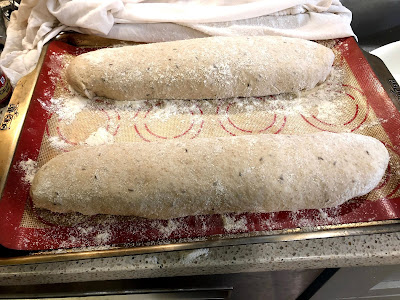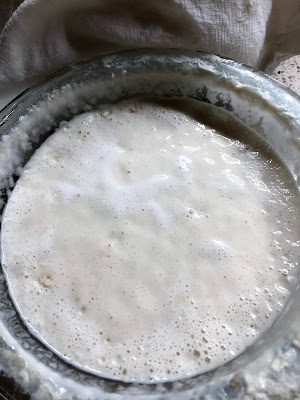When I was little, sometimes my father would go to the grocery store where he always indulged his wishes. He would come home not only with what my mother requested but always bought a small round loaf of thinly sliced rye bread. The diameter of the loaf was about three inches and I loved every slice of it that I got to eat (it was his treat, but he always shared with me). There's just something about caraway seeds - they really speak to me and I love rye bread.
So when I was looking through The Bread Bible, my first bread cookbook, I saw that Hensperger had a recipe for sourdough rye bread that I had never noticed before. Her book is not my go-to sourdough cookbook so I guess it had always missed my notice.
This is a three-day bread but my starter was ready to go. Her starter for this bread is made with just bread flour. I feed my starter half and half whole wheat and bread flour, so I decided to skip Day One and go with my already active starter even though it would not be purely the recipe to do this.
Day Two you make a mix of 1 cup of starter, 2 cups lukewarm water, 2 T molasses, 1 1/2 cups rye flour (I used pumpernickel since that was what I had) and 1 1/2 cups bread flour. This rises on the counter overnight.
On Day Three, you stir in 1 1/2 tsp of active dry yeast, 3 T canola oil, 2 T molasses, 4 tsp salt, 4 tsp of caraway seeds (mine were a little heaping), and 1/2 cup of rye flour (I used pumpernickel).
Beat the mixture well and then add 3 or so cups of bread flour 1/2 cup at a time.
Knead well and let bread dough rise for about an hour.
Turn the bread out of the rising bowl and shape into two long loaves on a baking sheet. Cover and let these rise for another 45 minutes to an hour.
Preheat oven to 450. I started preheating as soon as this loaf rise began. When the bread is ready, brush the surface of the loaf with beaten egg and sprinkle with more caraway seeds.
Put bread into oven and lower the temperature to 375. Bake for 40 to 45 minutes. Cool completely before slicing. It's WONDERFUL and meets my childhood memories fully.
Monday, April 27, 2020
Beth Hensperger's Pain de Campagne
Using my mother's sourdough starter paired with the deeply complex flavors generated in most of Beth Hensperger's recipes makes me very happy. In this time of the coronavirus, I, like many other people, am baking my heart out.
I give away Mother's starter frequently (about four times in a year) but now have given it to four people during the six or seven weeks so far of the stay-at-home time of the coronavirus. One young man who asked for it then drove to N Georgia to Helen to get flour ground in a local mill, the Nora Mill Granary. The grocery stores were all out of flour (as they continue to be) and he really wanted to get started with his sourdough. Generously, he brought me two huge bags - one of whole wheat and the other of high gluten bread flour.
Meanwhile I have been feeding my starter twice a day and it is really happy:
 The pictured loaf is the second one. The first one I gave away without taking its photo but it was prettier even than this one. The crust is crunchy and delicious and the bread has a nice crumb. I want to make it again and again!
The pictured loaf is the second one. The first one I gave away without taking its photo but it was prettier even than this one. The crust is crunchy and delicious and the bread has a nice crumb. I want to make it again and again!
I give away Mother's starter frequently (about four times in a year) but now have given it to four people during the six or seven weeks so far of the stay-at-home time of the coronavirus. One young man who asked for it then drove to N Georgia to Helen to get flour ground in a local mill, the Nora Mill Granary. The grocery stores were all out of flour (as they continue to be) and he really wanted to get started with his sourdough. Generously, he brought me two huge bags - one of whole wheat and the other of high gluten bread flour.
Meanwhile I have been feeding my starter twice a day and it is really happy:
Hensperger's recipe for Pain de Campagne takes three days. The first one, though, is the making of the starter and mine is already fully functioning. So I used the equivalent amount of starter and began the recipe with Day Two of three.
On Day Two, you make a sponge with 1/2 cup of starter (from the first day) and 2 cups of lukewarm water into which you stir 1 1/2 cups of bread flour and 1 1/2 cups of whole wheat flour. My flours from N Georgia were perfect for this. This mixture rises overnight - it's really wet and rises as a bubbly batter, more or less.
Then on Day Three (two for me), you stir down the sponge and gradually add a cup of bread flour and 4 tsp of salt. Then you add up to 3 more cups of flour - I added about 2 1/2 but I am in Atlanta where it is really humid and I often don't need as much flour as the recipe requires.
In her recipe, she calls for about 1 1/2 - 2 hours rising, but I left mine for 3 since I was using starter and not fresh yeast. Then I divided the dough in half and put each half in a banneton where it rose for another hour or so.
I baked it one loaf at a time in a cloche in a 500 degree oven. At 20 - 25 minutes I turned the oven down to 450 for 10 minutes. Then I took the top off for about 10 - 15 minutes more. The bread turned out beautifully:
 The pictured loaf is the second one. The first one I gave away without taking its photo but it was prettier even than this one. The crust is crunchy and delicious and the bread has a nice crumb. I want to make it again and again!
The pictured loaf is the second one. The first one I gave away without taking its photo but it was prettier even than this one. The crust is crunchy and delicious and the bread has a nice crumb. I want to make it again and again!
Subscribe to:
Comments (Atom)














